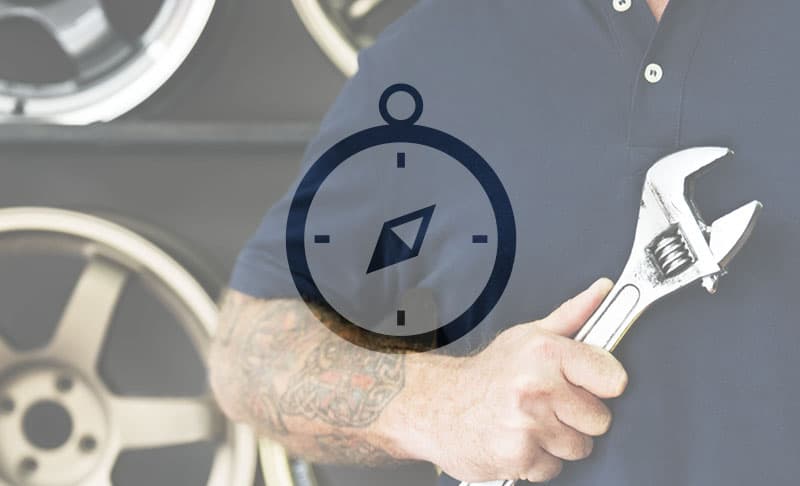
What to Check When Buying a Used Car: 10 Things to Look Out For
So, you’ve settled that all-important question of whether to buy a new or used car. Buying used can be a great way to get on the road without the hefty price tag of a new vehicle. But, how do you know a pre-owned vehicle is everything it was chalked up to be in the online ad?
The checklist below outlines what to look for when shopping for a used car through a private seller or dealer so you can make the purchase with peace of mind.
Key takeaways
- The vehicle’s history
- Rust or paint damage
- Frame issues
- Look under the hood
- Tire condition
- Mileage
- Interior electronics
- Upholstery
- Test drive it
- Mechanic inspection
Asking the right questions
When purchasing a used car, asking the right questions can help you avoid potential pitfalls and ensure you’re making a well-informed decision. Whether you’re dealing with a car dealership or a private seller, having a clear set of questions can help you uncover key insights about the vehicle’s condition, history, and overall value. Here’s a breakdown of the questions you should consider asking in different scenarios.
Questions for dealers
When buying from a car dealership, it’s important to ask questions that reveal the vehicle’s history and condition, as well as the dealership’s policies. Here are some key questions to consider:
- “Can I see the vehicle history report?”
Request a detailed vehicle history report from a reputable service like Carfax or AutoCheck. This report will provide information on past accidents, service records, and previous owners. - “Has the car been inspected by a certified mechanic?”
Ask if the vehicle has undergone a thorough inspection and if any repairs have been made. A pre-purchase inspection report can reveal potential issues. - “What is the warranty coverage on this vehicle?”
Inquire about any warranties or service contracts that come with the car to get a clear picture of what is covered, and for how long. - “What dealer fees or additional charges are involved?”
Clarify any additional costs, such as documentation fees, preparation fees, or extended warranty options. - “Can I take the car for an independent inspection?”
Ensure you have the option to have the car inspected by an independent mechanic of your choice before finalizing the purchase.
Questions for private sellers
Purchasing a used car from a private seller? Consider asking these questions to verify what shape it’s in.
- “Can I see the car’s maintenance records?”
Make a request for detailed maintenance records to understand how well the vehicle has been maintained over the years. - “Has the car been involved in any accidents?”
Ask about any past accidents or damage to the vehicle. This can help you identify potential issues and repairs which could impact costs in the long run. - “Why are you selling the car?”
Understanding the reason for the sale can provide insights into the car’s condition and whether there are any hidden issues. - “Can I see the title and registration?”
Verify that the seller has the legal title and registration for the car. This helps confirm ownership and ensures the car is not stolen or has any outstanding liens. - “Can I take the car for a test drive and an independent inspection?”
Always request a test drive to assess the car’s performance. Additionally, ask if you can have a mechanic perform a used car inspection to ensure there are no undeclared issues.
Why pre-purchase inspections are important
In a rush and thinking of skipping the pre-purchase inspection? Think again! This professional inspection is a crucial step of the used car buying process that can save you from expensive repairs and future regrets. Here’s how:
Uncover hidden issues
A thorough used car inspection can reveal underlying problems that may not be immediately apparent. This includes issues with the engine, transmission, brakes, and suspension. For Canadian buyers, especially in regions with harsh weather conditions like Manitoba, inspections can uncover rust, corrosion, and other damage caused by extreme temperatures and road salt.
Verify vehicle history
While a vehicle history report provides valuable information, it might not capture all mechanical issues. An inspection can verify that the vehicle’s condition aligns with the reported history, ensuring there are no discrepancies or hidden surprises.
Assess overall condition
A pre-purchase inspection provides a detailed assessment of the car’s overall condition and offers insight into its potential lifespan. This includes checking for wear and tear, alignment issues, and the status of critical components. Understanding the vehicle’s condition helps you make an informed decision about its value and future maintenance needs.
Negotiate better terms
Armed with the findings from a pre-purchase inspection, you can negotiate more effectively with the seller. If the inspection reveals issues, you can request repairs, a discount, or even reconsider the purchase altogether. This can lead to significant savings and prevent you from buying a car with more problems than its worth.
Compliance with safety standards
In Canada, vehicles must comply with specific safety standards. An inspection can confirm that the car meets these standards and is roadworthy, ensuring that it is safe for you and your passengers and providing you with peace of mind.
10 things to check before buying
1. The vehicle’s history
Get as much information as you can from the dealership or current owner, and then do your own research. Running the VIN (vehicle identification number) through a paid service like CARFAX will tell you if the car has been in an accident, if there are any liens on it, and if there are any recalls on the model.
2. Rust or paint damage
Take a walk around the used car and keep an eye out for any rusty spots or paint chips. Small, localized rust patches aren’t necessarily a deal breaker because they can be fixed fairly easily. If there are places where the metal is totally rusted through, you might want to reconsider the purchase.
3. Frame issues
While you’re walking around the pre owned vehicle, you should also look for problems with the frame. Is the car sitting level on the ground? Is there anything hanging from the undercarriage? Pay close attention to the bumpers and look inside the trunk and hood for new bolts or warping that could indicate a recent accident.
4. Look under the hood
The engine is the most important part of any vehicle. With the car turned off, pop the hood and visually inspect the engine for: fluid leaks, corrosion and cracked hoses and belts. Check the oil and transmission dipsticks for discolouration — oil should be light brown, transmission fluid should be pink or red.
5. Tire condition
The tire tread should be worn evenly and all four should match. Uneven tread or extra wear on a few of the tires often means poor alignment, which can be a symptom of steering, suspension or frame issues. A poorly aligned car will pull to the right or left when driving.
6. Mileage
The average car will rack up about 20,000 km each year. To figure out if the car you’re looking at has high or low mileage, divide the number on the odometer by the vehicle’s age. A used car with high mileage with have more wear and tear on its mechanical components. Find out more about why high mileage matters when buying a used car.
7. Interior electronics
Blasting the radio when your favourite song comes on is one of the little joys of car ownership. Press some buttons and make sure the stereo and the other electronic components in the cockpit are working properly. Turn on the air conditioning and heat as well.
8. Upholstery
Seats and interior fabric can take a beating in a vehicle. Thoroughly inspect the interior of the used car, watching out for tears, stains and cracked leather on all the front and back seats — upholstery can be a pricey thing to repair.
9. Test drive it
The test drive is probably the most important part of shopping for a used car. Plan your route and put the car through the paces to test its maneuverability, acceleration, braking and suspension. Take it on the highway, if possible, and try parallel parking to get a feel for any blind spots the car might have.
10. Mechanic inspection
If you think you’ve found the used car of your dreams you should take it to a trusted mechanic for an inspection. A mechanic can determine if the vehicle has any underlying issues or areas that might become an issue in the future. It’s not a free service, but it could save you from buying a lemon.
How to perform a proper test drive
A proper test drive is crucial in assessing the condition of a used car. Here’s a comprehensive guide on how to conduct an effective test drive, helping you make an informed decision before purchasing:
Prepare for the test drive
Before starting the test drive, take some time to familiarize yourself with the car’s features and controls. Adjust the seat, mirrors, and steering wheel to ensure a comfortable driving position. Familiarize yourself with the dashboard controls, infotainment system, and any other features that are important to you.
Evaluate the car’s comfort and handling
Pay attention to overall comfort of the used car, including seat comfort, electronics, cabin noise, and ride quality. Take note of how the vehicle handles different road conditions such as bumps, turns, and rough patches. This will give help you assess how comfortable and manageable the car will be for everyday driving.
Test various driving conditions
Drive the car in a variety of conditions to thoroughly evaluate its performance. This includes city driving, highway cruising, and even maneuvering in tight spaces if possible. Pay attention to acceleration, braking, and steering responsiveness. Testing the car in different environments will provide a more accurate picture of its overall performance.
Listen for unusual sounds
During the test drive, take note of unusual noises such as clunking, squeaking, or rattling. These sounds could signal potential mechanical issues or wear and tear. Be particularly attentive to the engine, transmission, and suspension noises.
Test the brakes and acceleration
Pay close attention to the car’s braking performance and acceleration. The brakes should be responsive and smooth, without any pulling or vibrations. Acceleration should be steady and consistent, without any hesitation or lag.
Evaluate visibility and maneuverability
Assess the car’s visibility from the driver’s seat. Check if there are any blind spots and ensure that the mirrors and windows provide adequate visibility. Test the car’s maneuverability by performing parking and turning exercises to ensure it handles well in tight spaces.
Take your time
Don’t rush the test drive. Take your time to thoroughly evaluate the vehicle and ensure that it meets your needs and expectations. If you have any concerns or questions, don’t hesitate to ask the seller or dealer for clarification.

Birchwood Credit Solutions has a huge inventory of used vehicles. We also offer in-house financing so you can get a loan and a car in one place, no matter your credit situation.



